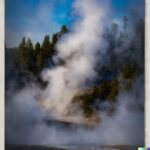Exploring the natural wonders of Yellowstone National Park is an unforgettable experience, but it’s important to do so responsibly. Leave No Trace is a set of principles that guide outdoor enthusiasts on how to minimize their impact on the environment.
In this article, we will discuss why it is crucial to practice Leave No Trace at Yellowstone National Park, the key principles to follow, and practical tips on how you can implement these principles during your visit. Let’s dive in and discover how you can enjoy the beauty of Yellowstone while preserving it for future generations.
What Is Leave No Trace?
Leave No Trace is a set of wilderness ethics that promote responsible behavior to minimize environmental impact and preserve the integrity of natural habitats.
It emphasizes the importance of enjoying and appreciating nature while ensuring that our presence does not harm the environment. By following the Leave No Trace principles, individuals can reduce their footprint on ecosystems, wildlife, and landscapes. This approach is crucial in fostering a deep respect for the natural world and encouraging sustainable travel practices.
Conservation efforts rely heavily on prioritizing the protection of delicate ecosystems and biodiversity through mindful outdoor activities. Leave No Trace serves as a guiding framework for outdoor enthusiasts to embrace a harmonious coexistence with the environment.
Why Is It Important to Leave No Trace at Yellowstone National Park?
Practicing Leave No Trace at Yellowstone National Park is crucial for maintaining sustainable travel practices, protecting wildlife, and preserving the natural beauty of this iconic national park.
By following Leave No Trace principles, visitors can minimize their impact on the delicate ecosystems within Yellowstone. Sustainable travel involves making conscious choices to reduce waste, tread lightly on the land, and respect wildlife habitats. Yellowstone is home to diverse flora and fauna, and it is essential to uphold conservation efforts that ensure the ecological balance of the park remains intact.
Respecting wildlife by observing from a safe distance and refraining from feeding or disturbing animals is paramount to their protection and to maintaining the park’s natural order.
What Are the Principles of Leave No Trace?
The principles of Leave No Trace encompass guidelines for ethical behavior, waste reduction, and environmental stewardship to promote sustainable practices and minimize the impact of human activities on natural ecosystems.
These principles serve as a framework for outdoor enthusiasts to engage with nature responsibly, ensuring that they leave behind no lasting trace of their presence in the wilderness. By adhering to these principles, individuals can reduce their ecological footprint, conserve natural resources, and preserve the integrity of wild spaces for future generations to enjoy. Emphasizing concepts such as proper waste disposal, respecting wildlife, and minimizing disturbance to fragile ecosystems, Leave No Trace principles empower individuals to become good stewards of the environment while fostering a sense of appreciation and connection to the natural world.
Plan Ahead and Prepare
Planning ahead and preparing adequately before embarking on outdoor adventures is essential to uphold Leave No Trace principles, minimize environmental impact, and ensure responsible behavior in natural settings.
By carefully considering factors such as choosing appropriate gear, packing out all waste, and familiarizing oneself with local regulations, outdoor enthusiasts can play a significant role in preserving the integrity of natural environments.
Understanding and adhering to ethical travel practices, such as respecting wildlife habitats and staying on designated trails, not only ensures a safer and more enjoyable experience for oneself but also contributes to the sustainability of these outdoor spaces for future generations to enjoy.
Embracing a mindset of stewardship and conservation is key in fostering a harmonious relationship between humans and the great outdoors.
Travel and Camp on Durable Surfaces
Traveling and camping on durable surfaces help reduce environmental impact, promote low impact camping practices, and contribute to conservation efforts aligned with Leave No Trace principles.
By choosing to set up camp on durable surfaces like gravel, rock, or established campsites, travelers can help prevent the destruction of fragile ecosystems and protect vegetation from being trampled. This practice not only preserves the natural beauty of the surroundings but also ensures that future generations can enjoy the same pristine wilderness.
Adhering to eco-friendly practices, such as packing out all trash, using biodegradable products, and minimizing campfire impact, is essential for sustainable tourism and minimizing carbon footprints while exploring the great outdoors.
Dispose of Waste Properly
Proper disposal of waste is a fundamental aspect of Leave No Trace, promoting waste reduction, eco-conscious behavior, and raising environmental awareness to protect natural resources.
This approach involves implementing waste reduction strategies, such as reducing, reusing, and recycling materials to minimize the impact on the environment. By consciously managing our waste, individuals can contribute to sustainable practices and take responsibility for their environmental footprint. It is imperative to cultivate a mindset that values the preservation of our natural surroundings, inspiring others to follow suit in promoting a cleaner and healthier planet for current and future generations.
Leave What You Find
Leaving natural surroundings as you found them is a core Leave No Trace principle that fosters nature conservation, encourages sustainable behavior, and upholds stewardship principles for outdoor environments.
By respecting and preserving the natural habitats we interact with, we contribute to the overall health and longevity of ecosystems. Practicing ethical guidelines for outdoor activities ensures that future generations can enjoy these spaces in their pristine state. Being mindful of our impact on the environment helps in maintaining biodiversity and protecting wildlife. Embracing the concept of Leave No Trace empowers individuals to make responsible choices while exploring the outdoors, ultimately creating a sustainable and harmonious relationship between humans and nature.
Minimize Campfire Impacts
Minimizing campfire impacts is essential in practicing Leave No Trace, involving ethical camping practices, adherence to outdoor etiquette, and considerations for wildlife management in natural habitats.
When individuals engage in outdoor activities like camping, they become part of the delicate ecosystem that thrives in these natural habitats. By reducing campfire impacts, they help protect the environment and the wildlife that call these areas home.
Ethical camping behaviors not only ensure that future generations can enjoy the same pristine landscapes but also play a crucial role in wildlife conservation efforts. Adhering to outdoor etiquette by following guidelines on campfire safety and proper waste disposal safeguards the fragile balance of ecosystems and promotes environmental protection.
Respect Wildlife
Respecting wildlife is a key aspect of Leave No Trace, emphasizing conservation guidelines, environmental education, and responsible behavior towards wildlife in their natural habitats.
Being mindful of the impact we have on the natural world is crucial for promoting eco-tourism and sustaining the rich biodiversity that exists in our ecosystems.
By following ethical wildlife viewing practices, such as observing animals from a safe distance, avoiding feeding them, and refraining from approaching their habitats too closely, we can protect these creatures from undue stress and disruption. This not only ensures the safety of both humans and wildlife but also preserves the delicate balance of nature for future generations to appreciate and enjoy.
Be Considerate of Other Visitors
Being considerate of other visitors is a fundamental principle of Leave No Trace, promoting responsible travel, waste reduction efforts, and ethical practices to enhance the outdoor experience for all.
By practicing outdoor etiquette and adopting sustainable behavior when exploring natural settings, outdoor enthusiasts can contribute to minimizing their impact on the environment. Simple actions like packing out all trash, staying on marked trails, and respecting wildlife habitats play a significant role in preserving the beauty and integrity of wilderness areas.
Following ethical guidelines such as leaving natural objects undisturbed and refraining from excessive noise pollution can ensure that everyone can enjoy the tranquility and serenity of the outdoors.”
How Can You Practice Leave No Trace at Yellowstone National Park?
Practicing Leave No Trace at Yellowstone National Park involves using existing campsites and trails, packing out all trash, and abiding by wildlife conservation guidelines to preserve the park’s natural beauty.
To ensure sustainable practices and environmental protection while visiting Yellowstone, visitors should prioritize using designated campsites to minimize impact on delicate ecosystems.
Proper waste disposal is crucial in maintaining the park’s cleanliness and preventing harm to wildlife. Remember to always pack out what you pack in, including food scraps and biodegradable items.
Respecting wildlife conservation efforts means observing animals from a safe distance and refraining from feeding them.
By following these guidelines, visitors can play a vital role in preserving Yellowstone for future generations to enjoy.
Use Existing Campsites and Trails
Using existing campsites and trails is essential in Leave No Trace practices to minimize environmental impact, uphold outdoor principles, and preserve natural habitats for future generations.
- By sticking to designated campsites, outdoor enthusiasts can help protect fragile ecosystems, prevent soil erosion, and reduce human impact on wildlife habitats.
- Following established trails not only ensures safety but also minimizes the risk of getting lost and damaging the surrounding vegetation.
- Respecting these guidelines plays a crucial role in promoting sustainable recreation and fostering a deeper connection with nature.
- By adhering to these outdoor ethics, individuals can contribute to the conservation of wilderness areas and promote responsible outdoor stewardship.
Pack Out All Trash and Waste
Ensuring all trash and waste is packed out is a critical aspect of Leave No Trace, promoting waste reduction, supporting wildlife conservation efforts, and maintaining the pristine environment of Yellowstone National Park.
By adhering to these eco-friendly practices, visitors contribute to the stewardship principles that are essential in preserving the fragile ecosystem of the park. Proper waste management not only prevents pollution but also safeguards the habitats of various wildlife species. Each piece of trash left behind can have harmful consequences, disrupting the natural balance and beauty of the park.
Therefore, taking responsibility for our waste and leaving no trace behind is a moral obligation that ensures future generations can also enjoy the unspoiled wilderness of Yellowstone.
Do Not Feed or Approach Wildlife
Avoiding feeding or approaching wildlife is crucial in Leave No Trace ethics, adhering to wildlife protection guidelines, promoting ethical behavior, and fostering a safe environment for both animals and visitors.
Respecting wildlife from a distance not only reduces the risk of harm to both animals and humans but also maintains the natural behavior of the wildlife population. By refraining from feeding wild animals, eco-tourists can prevent negative impacts such as habituation, alteration of natural diets, and spread of diseases.
Practicing responsible ecotourism involves observing wildlife in their natural habitats without disrupting their daily routines, ensuring their well-being and the integrity of the environment. It’s essential for travelers to prioritize environmental awareness and ethical considerations in all interactions with wildlife.
Follow Park Regulations and Guidelines
Adhering to park regulations and guidelines is essential for practicing Leave No Trace, demonstrating responsible behavior, and supporting sustainability initiatives that aim to protect the natural resources of Yellowstone National Park.
By following these regulations, visitors can minimize their impact on the environment, preserve wildlife habitats, and maintain the pristine beauty of the park for future generations. Responsible behavior includes proper waste disposal, respecting wildlife, staying on designated trails, and avoiding littering or vandalism. These practices align with the core principles of environmental responsibility and conservation, fostering a culture of respect and appreciation for the natural world.
Embracing these guidelines not only enhances the visitor experience but also plays a crucial role in safeguarding the ecological integrity of Yellowstone and other wilderness areas.
Educate Yourself and Others on Leave No Trace Principles
Educating yourself and others on Leave No Trace principles is key to fostering environmental awareness, promoting nature ethics, and encouraging active participation in environmental conservation efforts.
By learning about Leave No Trace principles, individuals can cultivate a deeper understanding of how their actions impact the environment. This knowledge empowers them to make informed decisions that prioritize sustainability and conservation.
Environmental education plays a crucial role in instilling stewardship values, guiding people towards responsible outdoor practices. By sharing knowledge about sustainable behavior, we can collectively work towards preserving our natural spaces for future generations.
Last Updated on February 11, 2024 by Jon Waraas – Originally Posted: February 11, 2024

I’m Jon Waraas, and I’ve been navigating the online world since 2006. By day, I’m the proud owner of some eCommerce gems, and by night, I’m the voice behind the adventures on Waraas.Com.
My heart, however, belongs to the wild beauty of Yellowstone National Park. I’ve got a collection of websites dedicated to sharing the wonders of this natural masterpiece. Oh, and did I mention? I’m currently building my own cabin inside the ghost town of Gilmore, Idaho – a cabin with tales to tell!
When I’m not immersed in the digital realm, you’ll find me lacing up my boots for a good hike or setting up camp under the star-studded sky.




